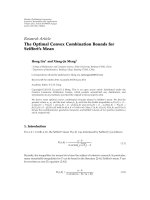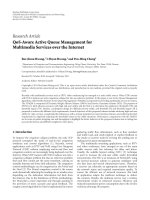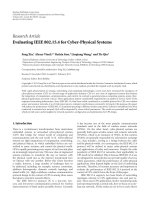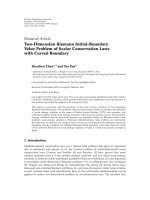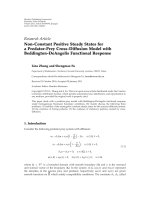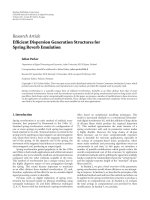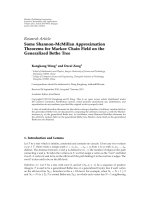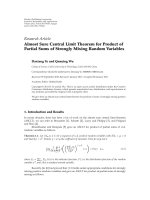Báo cáo hóa học: " Research Article Almost Sure Central Limit Theorem for Product of Partial Sums of Strongly Mixing Random Variables" docx
Bạn đang xem bản rút gọn của tài liệu. Xem và tải ngay bản đầy đủ của tài liệu tại đây (491.22 KB, 9 trang )
Hindawi Publishing Corporation
Journal of Inequalities and Applications
Volume 2011, Article ID 576301, 9 pages
doi:10.1155/2011/576301
Research Article
Almost Sure Central Limit Theorem for Product of
Partial Sums of Strongly Mixing Random Variables
Daxiang Ye and Qunying Wu
College of Science, Guilin University of Technology, Guilin 541004, China
Correspondence should be addressed to Daxiang Ye,
Received 19 September 2010; Revised 1 January 2011; Accepted 26 January 2011
Academic Editor: Ond
ˇ
rej Do
ˇ
sl
´
y
Copyright q 2011 D. Ye and Q. Wu. This is an open access article distributed under the Creative
Commons Attribution License, which permits unrestricted use, distribution, and reproduction in
any medium, provided the original work is properly cited.
We give here an almost sure central limit theorem for product of sums of strongly mixing positive
random variables.
1. Introduction and Results
In recent decades, there has been a lot of work on the almost sure central limit theorem
ASCLT, we can refer to Brosamler 1, Schatte 2, Lacey and Philipp 3, and Peligrad
and Shao 4.
Khurelbaatar and Rempala 5 gave an ASCLT for product of partial sums of i.i.d.
random variables as follows.
Theorem 1.1. Let {X
n
,n ≥ 1} be a sequence of i.i.d. positive random variables with EX
1
μ>0
and VarX
1
σ
2
. Denote γ σ/μ the coefficient of variation. Then for any real x
lim
n →∞
1
ln n
n
k1
1
k
I
⎛
⎝
k
i1
S
i
k!μ
k
1/γ
√
k
≤ x
⎞
⎠
F
x
a.s.,
1.1
where S
n
n
k1
X
k
, I∗ is the indicator function, F· is the distribution function of the random
variable e
N
, and N is a standard normal variable.
Recently, Jin 6 had p roved that 1.1 holds under appropriate conditions for strongly
mixing positive random variables and gave an ASCLT for product of partial sums of strongly
mixing as follows.
2 Journal of Inequalities and Applications
Theorem 1.2. Let {X
n
,n ≥ 1} be a sequence of identically distributed positive strongly mixing
random variable with EX
1
μ>0 and VarX
1
σ
2
, d
k
1/k, D
n
n
k1
d
k
. Denote by
γ σ/μ the coefficient of variation, σ
2
n
Var
n
k1
S
k
− kμ/kσ and B
2
n
VarS
n
. Assume
E
|
X
1
|
2δ
< ∞ for some δ>0, lim
n →∞
B
2
n
n
σ
2
0
> 0,
α
n
O
n
−r
for some r>1
2
δ
, inf
n∈N
σ
2
n
n
> 0.
1.2
Then for any real x
lim
n →∞
1
D
n
n
k1
d
k
I
⎛
⎝
k
i1
S
i
k!μ
k
1/γσ
k
≤ x
⎞
⎠
F
x
a.s. 1.3
The sequence {d
k
,k ≥ 1} in 1.3 is called weight. Under the conditions of Theorem 1.2,
it is easy to see that 1.3 holds for every sequence d
∗
k
with 0 ≤ d
∗
k
≤ d
k
and D
∗
n
k≤n
d
∗
k
→∞
7. Clearly, the larger the weight sequence d
k
is, the stronger is the result 1.3.
In the following sections, let d
k
e
ln k
α
/k,0≤ α<1/2,D
n
n
k1
d
k
,“” denote the
inequality “≤” up to some universal constant.
We first give an ASCLT for strongly mixing positive random variables.
Theorem 1.3. Let {X
n
,n ≥ 1} be a sequence of identically distributed positive strongly mixing
random variable with EX
1
μ>0 and VarX
1
σ
2
, d
k
and D
n
as mentioned above. Denote
by γ σ/μ the coefficient of variation, σ
2
n
Var
n
k1
S
k
− kμ/kσ and B
2
n
VarS
n
. Assume
that
E
|
X
1
|
2δ
< ∞ for some δ>0,
1.4
α
n
O
n
−r
for some r>1
2
δ
, 1.5
lim
n →∞
B
2
n
n
σ
2
0
> 0, 1.6
inf
n∈N
σ
2
n
n
> 0.
1.7
Then for any real x
lim
n →∞
1
D
n
n
k1
d
k
I
⎛
⎝
k
i1
S
i
k!μ
k
1/γσ
k
≤ x
⎞
⎠
F
x
a.s. 1.8
In order to prove Theorem 1.3 we first establish ASCLT for certain triangular arrays of
random variables. In the sequel we shall use the following notation. Let b
k,n
n
ik
1/i and
s
2
k,n
k
i1
b
2
i,n
for k ≤ n with b
k,n
0ifk>n. Y
k
X
k
− μ/σ, k ≤ 1,
S
n
n
k1
Y
k
and
S
n,n
n
k1
b
k,n
Y
k
.
Journal of Inequalities and Applications 3
In this setting we establish an ASCLT for the triangular array b
k,n
Y
k
.
Theorem 1.4. Under the conditions of Theorem 1.3, for any real x
lim
n →∞
1
D
n
n
k1
d
k
I
S
k,k
σ
k
≤ x
Φ
x
a.s.,
1.9
where Φx is the standard normal distribution function.
2. The Proofs
2.1. Lemmas
To prove theorems, we need the following lemmas.
Lemma 2.1 see 8. Let {X
n
,n ≥ 1} be a sequence of strongly mixing random variables with zero
mean, and let {a
k,n
, 1 ≤ k ≤ n, n ≥ 1} be a triangular array of real numbers. Assume that
sup
n
n
k1
a
2
k,n
< ∞, max
1≤k≤n
|
a
k,n
|
−→ 0 as n −→ ∞.
2.1
If for a certain δ>0, {|X
k
|
2δ
} is uniformly integrable, inf
k
VarX
k
> 0,
∞
n1
n
2/δ
α
n
< ∞, Var
n
n1
a
k,n
X
k
1, 2.2
then
n
k1
a
k,n
X
k
d
−−−→
N
0, 1
.
2.3
Lemma 2.2 see 9. Let d
k
e
ln k
α
/k, 0 ≤ α<1/2,D
n
n
k1
d
k
;then
D
n
∼ C
ln n
1−α
exp
ln n
α
,
2.4
where C 1/α as 0 <α<1/2,C 1 as α 0.
Lemma 2.3 see 8. Let {X
n
,n ≥ 1} be a strongly mixing sequence of random variables such that
sup
n
E|X
n
|
2δ
< ∞ for a certain δ>0 and every n ≥ 1. Then there is a numerical constant cδ
depending only on δ such that for every n>1 one has
sup
j
nj
ij1
Cov
X
i
,X
j
≤ c
δ
n
i1
i
2/δ
α
i
δ/2δ
sup
k
X
k
2
2δ
,
2.5
where X
k
p
E|X
k
|
p
1/p
,p>1.
4 Journal of Inequalities and Applications
Lemma 2.4 see 9. Let {ξ
k
,k ≥ 1} be a sequence of random variables, uniformly bounded below
and with finite variances, and let {d
k
,k ≥ 1} be a sequence of positive number. Let for n ≥ 1,D
n
n
k1
d
k
and T
n
1/D
n
n
k1
d
k
ξ
k
. Assume that
D
n
−→ ∞
D
n1
D
n
−→ 1,
2.6
as n →∞.Ifforsomeε>0, C and all n
ET
2
n
≤ C
ln
−1−ε
D
n
, 2.7
then
T
n
a.s.
−−−−→ 0 as n −→ ∞.
2.8
Lemma 2.5 see 10. Let {X
n
,n≥ 1} be a strongly mixing sequence of random variables with zero
mean and sup
n
E|X
n
|
2δ
< ∞ for a certain δ>0. Assume that 1.5 and 1.6 hold. Then
lim sup
n →∞
|
S
n
|
2σ
2
0
n ln ln n
1 a.s.
2.9
2.2. Proof of Theorem 1.4
From the definition of strongly mixing we know that {Y
k
,k ≥ 1} remain to be a sequence of
identically distributed strongly mixing random variable with zero mean and unit variance.
Let a
k,n
b
k,n
/σ
n
;notethat
n
k1
b
2
k,n
b
1,n
2
n
k2
k−1
i1
1
k
b
1,n
2
n
k2
k − 1
k
2n − b
1,n
,n≥ 1,
2.10
and via 1.7 we have
sup
n
n
k1
a
2
k,n
sup
n
n
k1
b
2
k,n
σ
2
n
sup
n
2n − b
1,n
n
< ∞,
max
1≤k≤n
|
a
k,n
|
max
1≤k≤n
b
k,n
σ
n
ln n
√
n
−→ 0,n−→ ∞.
2.11
From the definition of Y
k
and 1.4 we have that {|Y
k
|
2δ
} is uniformly integrable; note
that
inf
k
Var
Y
k
EY
2
1
1 > 0, Var
n
k1
a
k,n
Y
k
Var
n
k1
b
k,n
Y
k
σ
2
n
1,
2.12
Journal of Inequalities and Applications 5
and applying 1.5
∞
n1
n
2/δ
α
n
∞
n1
n
−r2/δ
< ∞.
2.13
Consequently using Lemma 2.1, we can obtain
S
n,n
σ
n
d
−−−→N
0, 1
as n −→ ∞,
2.14
which is equivalent to
Ef
S
n,n
σ
n
−→ Ef
N
as n −→ ∞
2.15
for any bounded Lipschitz-continuous function f; applying Toeplitz Lemma
1
D
n
n
k1
d
k
Ef
S
k,k
σ
k
−→ Ef
N
as n −→ ∞.
2.16
We notice that 1.9 is equivalent to
lim
n →∞
1
D
n
n
k1
d
k
f
S
k,k
σ
k
Φ
x
a.s.
2.17
for all bounded Lipschitz continuous f; it therefore remains to prove that
T
n
1
D
n
n
k1
d
k
f
S
k,k
σ
k
− Ef
S
k,k
σ
k
a.s.
−−−−→
0,n−→ ∞.
2.18
Let ξ
k
fS
k,k
/σ
k
− EfS
k,k
/σ
k
,
E
n
k1
d
k
ξ
k
2
≤ E
2
1≤k≤l≤n
d
k
d
l
ξ
k
ξ
l
1≤k≤l≤n
d
k
d
l
|
E
ξ
k
ξ
l
|
1≤k≤l≤n
l≤2k
d
k
d
l
|
E
ξ
k
ξ
l
|
1≤k≤l≤n
l>2k
d
k
d
l
|
E
ξ
k
ξ
l
|
T
1,n
T
2,n
.
2.19
From Lemma 2.2, we obtain for some constant C
1
e
ln n
α
∼ C
1
D
n
ln D
n
1−1/α
.
2.20
6 Journal of Inequalities and Applications
Using 2.20 and property of f, we have
T
1,n
e
ln n
α
n
k1
d
k
2k
lk
1
l
D
n
e
ln n
α
D
2
n
ln D
n
1−1/α
.
2.21
We estimate now T
2,n
. For l>2k,
S
l,l
− S
2k,2k
b
1,l
Y
1
b
2,l
Y
2
··· b
l,l
Y
l
−
b
1,2k
Y
1
b
2,2k
Y
2
··· b
2k,2k
Y
2k
b
2k1,l
S
2k
b
2k1,l
Y
2k1
··· b
l,l
Y
l
.
2.22
Notice that
|
Eξ
k
ξ
l
|
Cov
f
S
k,k
σ
k
,f
S
l,l
σ
l
≤
Cov
f
S
k,k
σ
k
,f
S
l,l
σ
l
− f
S
l,l
− S
2k,2k
− b
2k1,l
S
2k
σ
l
Cov
f
S
k,k
σ
k
,f
S
l,l
− S
2k,2k
− b
2k1,l
S
2k
σ
l
,
2.23
and the properties of strongly mixing sequence imply
Cov
f
S
k,k
σ
k
,f
S
l,l
− S
2k,2k
− b
2k1,l
S
2k
σ
l
α
k
.
2.24
Applying Lemma 2.3 and 2.10,
Var
S
2k,2k
2k
i1
b
2
i,2k
EY
2
i
2
2k−1
j1
2k
ij1
b
i,2k
b
j,2k
Cov
Y
i
,Y
j
≤
2k
i1
b
2
i,2k
2
2k−1
j1
b
2
j,2k
2k
ij1
Cov
Y
i
,Y
j
k,
Var
S
2k
E
2k
i1
Y
i
2
2k
i1
EY
2
i
2
2k−1
i1
2k
ji1
Cov
Y
i
,Y
j
k.
2.25
Journal of Inequalities and Applications 7
Consequently, via the properties of f,the Jensen inequality, and 1.7,
Cov
f
S
k,k
σ
k
,f
S
l,l
σ
l
− f
S
l,l
− S
2k,2k
− b
2k1,l
S
2k
σ
l
E
S
2k,2k
b
2k1,l
S
2k
σ
l
≤
ES
2
2k,2k
σ
l
E
b
2k1,l
S
2k
2
σ
l
Var
S
2k,2k
σ
l
b
2k1,l
Var
S
2k
σ
l
k
l
β
,
2.26
where 0 <β<1/2. Hence for l>2k we have
|
Eξ
k
ξ
l
|
α
k
k
l
β
.
2.27
Consequently, we conclude from the above inequalities that
T
2,n
1≤k≤l≤n
l>2k
d
k
d
l
α
k
k
l
β
1≤k≤l≤n
l>2k
d
k
d
l
α
k
1≤k≤l≤n
l>2k
d
k
d
l
k
l
β
T
2,n,1
T
2,n,2
.
2.28
Applying 1.5 and Lemma 2.2 we can obtain for any η>0
T
2,n,1
≤
n
k1
n
l1
d
k
d
l
α
k
ln D
n
−1−η
n
k1
d
k
n
l1
d
l
D
2
n
ln D
n
−1−η
.
2.29
Notice that
T
2,n,2
1≤k≤l≤n
l>2k
l/k≥
ln D
n
2/β
d
k
d
l
k
l
β
1≤k≤l≤n
l>2k
l/k<
ln D
n
2/β
d
k
d
l
k
l
β
T
2,n,2,1
T
2,n,2,2
,
2.30
T
2,n,2,1
≤
1≤k≤l≤n
l>2k
d
k
d
l
ln D
n
−2
≤
ln D
n
−2
n
k1
d
k
n
l1
d
l
D
2
n
ln D
n
−2
.
2.31
8 Journal of Inequalities and Applications
Let n
0
max{l : k ≤ l ≤ n, l/k < ln D
n
2/β
}, then
T
2,n,2,2
≤
n
k1
n
0
l2k
d
k
d
l
≤ e
ln n
α
n
k1
d
k
n
0
l2k
1
l
e
ln n
α
n
k1
d
k
ln n
0
− ln 2k
e
ln n
α
D
n
ln ln D
n
D
2
n
ln
1−1/α
D
n
ln ln D
n
.
2.32
By 2.21, 2.29, 2.31,and2.32, for some ε>0 such that
ET
2
n
1
D
2
n
E
n
k1
d
k
ξ
k
2
ln D
n
−1−ε
,
2.33
applying Lemma 2.4, we have
T
n
a.s.
−−−−→ 0.
2.34
2.3. Proof of Theorem 1.3
Let C
k
S
k
/μk; we have
1
γσ
n
n
k1
C
k
− 1
1
γσ
n
n
k1
S
k
μk
− 1
1
σ
n
n
k1
b
k,n
Y
k
S
n,n
σ
n
.
2.35
We see that 1.9 is equivalent to
lim
n →∞
1
D
n
n
k1
d
k
I
1
γσ
k
k
i1
C
i
− 1
≤ x
Φ
x
, a.s. ∀x.
2.36
Note that in order to prove 1.8 it is sufficient to show that
lim
n →∞
1
D
n
n
k1
d
k
I
1
γσ
k
k
i1
ln C
i
≤ x
Φ
x
, a.s. ∀x.
2.37
From Lemma 2.5,forsufficiently large k, we have
|
C
k
− 1
|
O
ln
ln k
k
1/2
. 2.38
Since ln1 xx Ox
2
for |x| < 1/2, thus
n
k1
ln
C
k
−
n
k1
C
k
− 1
n
k1
C
k
− 1
2
n
k1
ln
ln k
k
ln n ln
ln n
a.s.
2.39
Journal of Inequalities and Applications 9
Hence for any ε>0andforsufficiently large n, we have
I
1
γσ
n
n
k1
C
k
− 1
≤ x − ε
≤ I
1
γσ
n
n
k1
ln C
k
≤ x
≤ I
1
γσ
n
n
k1
C
k
− 1
≤ x ε
2.40
and thus 2.36 implies 2.37.
Acknowledgment
This work is supported by the National Natural Science Foundation of China 11061012,
Innovation Project of Guangxi Graduate Education 200910596020M29.
References
1 G. A. Brosamler, “An almost everywhere central limit theorem,” Mathematical Proceedings of the
Cambridge Philosophical Society, vol. 104, no. 3, pp. 561–574, 1988.
2 P. Schatte, “On strong versions of the central limit theorem,” Mathematische Nachrichten, vol. 137, pp.
249–256, 1988.
3 M. T. Lacey and W. Philipp, “A note on the almost sure central limit theorem,” Statistics & Probability
Letters, vol. 9, no. 3, pp. 201–205, 1990.
4 M. Peligrad and Q. M. Shao, “A note on the almost sure central limit theorem for weakly dependent
random variables,” Statistics & Probability Letters, vol. 22, no. 2, pp. 131–136, 1995.
5 G. Khurelbaatar and G. Rempala, “A note on the almost sure central limit theorem for the product of
partial sums,” Applied Mathematics Letters, vol. 19, pp. 191–196, 2004.
6 J. S. Jin, “An almost sure central limit theorem for the product of partial sums of strongly missing
random variables,” Journal of Zhejiang University, vol. 34, no. 1, pp. 24–27, 2007.
7 I. Berkes and E. Cs
´
aki, “A universal result in almost sure central limit theory,” Stochastic Processes and
Their Applications, vol. 94, no. 1, pp. 105–134, 2001.
8 M. Peligrad and S. Utev, “Central limit theorem for linear processes,” The Annals of Probability, vol. 25,
no. 1, pp. 443–456, 1997.
9 F. Jonsson, Almost Sure Central Limit Theory, Uppsala University: Department of Mathematics, 2007.
10 L. Chuan-Rong and L. Zheng-Yan, Limit Theory for Mixing Dependent Random Variabiles, Science Press,
Beijing, China, 1997.
